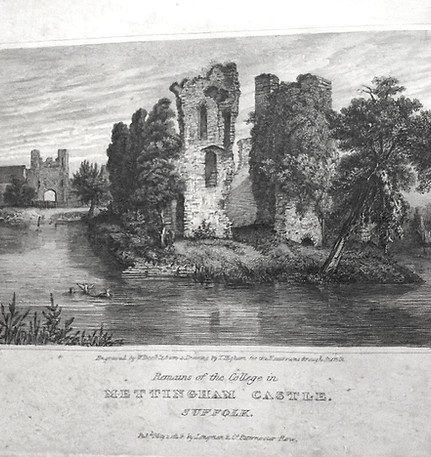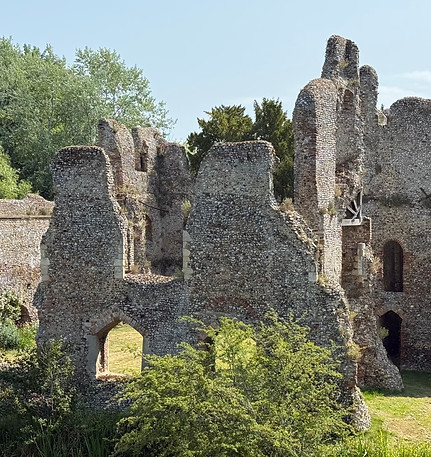Explore Mettingham Castle
Discover the History
Origins and Foundation (1342-1373)
Mettingham Castle's story begins in 1342 when King Edward III granted Sir John de Norwich a licence to crenellate his manor house in the extreme south-west corner of Mettingham parish, near Bungay in Suffolk. This fortification was a reward for Sir John's distinguished military service, having fought in numerous campaigns against the Scots and French from 1322 onwards. He served as Admiral of the coast from the Thames northwards between 1335-37, was Lieutenant to the Seneschal of Gascony in 1338, and fought as a banneret at the Battle of Crécy in 1346.
The castle's position was unusual for a principal manor, being situated near the parish boundary adjacent to Mettingham Green rather than near the church. This peripheral location suggests it was associated with a late, minor manor rather than an established power base. The impressive ruins that survive today consist of two conjoined moated areas or baileys, entered through a dramatic gatehouse, with a stone curtain wall partially surrounding the northern bailey and the remains of a stone tower or keep between the baileys.

The Norwich Dynasty and Early Troubles (1373-1394)
The Norwich family's tenure at Mettingham ended abruptly when the male line died out in 1373 with the death of Sir John's grandson, another Sir John, while abroad in the King's service. The property passed to a female cousin, Catherine de Brewse, who later became a nun at Dartford in Kent. Upon Catherine's death in 1380, the estate was intended to be transferred to the College of Secular Canons that Sir John de Norwich had founded at Raveningham in Norfolk in 1350.
However, before this transfer could be completed, Mettingham Castle was attacked and ransacked on two successive days during the Peasants' Revolt of 1381. The timing was particularly unfortunate, occurring in June just before the planned handover. In July of the same year, Catherine's trustees temporarily leased the castle for three years to her cousin and heir, William de Ufford, second Earl of Suffolk, presumably to safeguard it from further attack. When William died shortly afterwards, the trustees finally succeeded in transferring the castle to the College at Raveningham in 1382.
The College Years (1394-1542)
The College of Secular Canons did not actually move to Mettingham until 1394, establishing what would become a 148-year period of ecclesiastical occupation. By 1535, the College consisted of a Master, nine Fellows, and fourteen boys who were maintained and educated at the site. The canons constructed or adapted substantial buildings within the castle walls, including an impressive mansion house that featured an aisled hall, parlour with gilded decorations, guest chambers, kitchen facilities, and service buildings.
The 1562 survey reveals the complexity of the collegiate buildings, describing a stone-walled mansion entered through a double-storeyed porch with a lead roof. The hall measured 46 feet long by 30 feet wide with 6-foot-wide aisles, an open tiled roof, and brick flooring. The parlour featured a stone bay-window overlooking a little court, wainscot ceiling with carved and gilded decorations, and displayed the arms of Richard Shelton, who served as Master from 1517 until 1539. The college also maintained orchards, gardens, fishponds, and various service buildings including a bakehouse, brewhouse, and the intriguingly named 'Cynnyhalle' - possibly a royal guest house for important visitors.


Dissolution and Decay
(1542-1563)
The College surrendered to the Crown in 1542 during Henry VIII's Dissolution of the Monasteries, with Thomas Manning, suffragan Bishop of Ipswich and former Prior of Butley, serving as the last Master. The property was immediately regranted to Sir Anthony Denny of Cheshunt in Hertfordshire, marking the end of its ecclesiastical function. By this time, the ancient keep was already described as 'utterly decayed' with 'divers of the walls fallen down', though remarkably a layer chimney of freestone still stood with two great iron bars supporting part of it.
In 1563, just twenty-one years after the dissolution, the castle was sold to Sir Nicholas Bacon of Redgrave, the Lord Keeper and father of the future statesman Sir Francis Bacon. Bacon had commissioned his surveyor John Hille to conduct a detailed survey in 1562, which provides an invaluable snapshot of the castle's condition. The survey revealed a site still surrounded by a 30-foot high stone wall, though already decayed in places, with the mansion house still largely intact but showing signs of abandonment and partial dilapidation, including 'utterly decayed' porter's lodgings and a roofless stable.
Later History and Archaeological Legacy
(1563-Present)
Following Sir Nicholas Bacon's acquisition, Mettingham Castle continued its gradual decline while serving various domestic purposes. By the mid-17th century, the antiquarian William Blois recorded surviving heraldic displays, noting coats of arms of Norwich, Ufford, Shelton, and other families associated with the site's history. An 'old house' that had served as a farmhouse was eventually demolished in the 1820s when the Safford family built a new mansion, reportedly 'retaining an angle of the old keep'. The historian Alfred Suckling, who was parish curate at the time, observed that the demolition revealed interior decorations 'long hid' that were found 'in excellent preservation'.
This Victorian house was itself demolished around 1880, leaving behind a fragmentary flint and brick structure that may represent part of the medieval 'Cynnyhalle'. Today, Mettingham Castle stands as a Scheduled Ancient Monument and Grade II* listed building, though it remains on Historic England's Heritage at Risk Register. Recent conservation efforts, including a grant from Historic England, have funded repairs to stabilise the flint gatehouse and curtain wall, building on earlier work completed in 2009 that addressed the keep and part of the curtain wall, helping to secure this remarkable site's future for generations to come.

